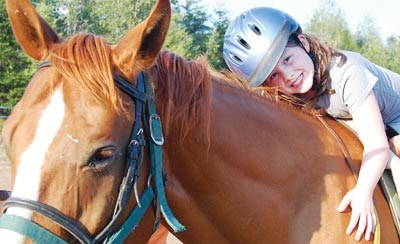Nathalie Henri has been riding for about eight years, yet she still can’t help but giggle as she swings her leg over Pepper’s back.
The speckled Appaloosa pony patiently waits while Monica Bretzlaff-Nearing, Henri’s instructor, adjusts the stirrups. Sixteen-year-old Henri quietly picks up her reins, still smiling from ear to ear.
Then they’re off.
It’s the scene on any given Tuesday or Thursday evening during the summer on Dupuis Road in Hanmer. Henri is one of about 30 riders who benefits from the Sudbury Therapeutic Riding Program (STRP).
“Everything that we do, I believe, helps the rider, physically, emotionally and cognitively,” Bretzlaff-Nearing said.
With the help of a lead guiding the horse, and in some case, side-walkers next to the rider’s foot, people with disabilities can develop stronger bodies, make new friends and experience a whole new kind of freedom.

Eleven-year-old Alicia Chenier has been riding with the Sudbury Therapeutic Riding Program for about three years, but it was her first time riding Diablo. She said he is a “very nice” horse, and likes riding because “it’s just really fun.” Photo by Jenny Jelen
“It benefits the riders,” Isabelle Langman, president of STRP, said. “We see it — we see it in their faces. Some of them come with some emotional challenges and this brightens them up, they smile, (when) they interact with the horses.”
The program helps people with conditions like cerebral palsy, Down’s syndrome, traumatic brain injuries, stroke, muscular dystrophy, autism, multiple sclerosis and many others.
Instructors Bretzlaff-Nearing, Julia Mallyon and Spenser Shaw make learning fun for riders by playing games and doing obstacle courses with them.
Langman said riders always start their session with stretches, which helps them to limber up and become more comfortable on horseback.
“Inadvertently, it does increase their balance, because they don’t realize they’re doing two things at once,” Langman said.
As riders progress through the program, they rely less and less on helpers, and more on their own skills.
“The more advanced riders will only have a lead, and it’s a very loose lead, so they are the ones essentially controlling the horse by themselves,” Langman said.
Langman said she has “absolutely no horse background whatsoever,” but got involved with the program because of her daughter, Alissa, about 11 years ago.
Allergies cause both the Langman girls to sniffle, but they still enjoy being at the farm.
“(The horses) are all such lovable creatures,” Langman said.
In order for riders to get involved in the program, Langman explained they must first be assessed by a physiotherapist, to determine which horse will best suit their needs. Along the way, riders are reassessed, to ensure they are still getting the most out of the experience.
“If they need a horse that’s wider (through the) girth, just for a good stretch, they’ll move onto a wider horse,” Langman said. “They might start small, and move up along the way.”
The program keeps five horses of different shapes and sizes to help accommodate riders.
Langman said it’s important for the horses to be healthy and fit, and have “good strong structure, strong bones and nice limbs.” A quiet demeanor is even more important though, since the horses are hauling precious cargo. “We want them to be nice and calm and peaceful.”
Many of the STRP horses even seem to know which rider is riding them, Langman said.

Monica Bretzlaff-Nearing helps Nathalie Henri climb aboard Pepper, a 12-year-old Appaloosa pony, before beginning a lesson. Photo by Jenny Jelen
“They know,” she said. “(Some think) I’m going to be silly now, because I know she’s silly, or I’m going to take it easy, because I know I have to take it easy. It’s amazing, because they know. They’re quite adept with that.”
To keep the program running, STRP relies on fundraising and volunteers.
Even though caring for the horses is costly, Langman said it’s a worthwhile cause.
“It’s a very expensive endeavor, but it benefits everybody,” Langman said. “As long as we can continue to do that, and continue seeing improvement in our riders, it’s all worth the expense.”
Henri’s mom, Nicole Henri, said the experience has proved to be a good one for her daughter.
“The program has shown her a sense of companionship and responsibility towards the horses,” she said. “Those horses are special, they seem to have a connection with children with learning disabilities. As parents, we find it very rewarding seeing her smile and what she has accomplished. For Nathalie, she truly enjoys her horseback riding and the social interaction with the volunteers.”
STRP volunteers don’t need horse experience, but it can often help out. “We appreciate every single volunteer that comes,” Langman said.
For more information about STRP, or to become a volunteer, e-mail [email protected] or visit www.strp.ca.
